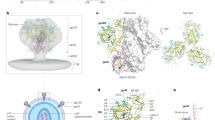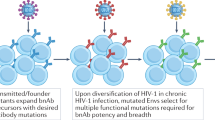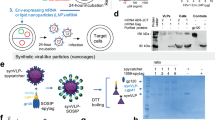Abstract
Current human immunodeficiency virus-1 (HIV-1) vaccines elicit strain-specific neutralizing antibodies. However, cross-reactive neutralizing antibodies arise in approximately 20% of HIV-1-infected individuals, and details of their generation could provide a blueprint for effective vaccination. Here we report the isolation, evolution and structure of a broadly neutralizing antibody from an African donor followed from the time of infection. The mature antibody, CH103, neutralized approximately 55% of HIV-1 isolates, and its co-crystal structure with the HIV-1 envelope protein gp120 revealed a new loop-based mechanism of CD4-binding-site recognition. Virus and antibody gene sequencing revealed concomitant virus evolution and antibody maturation. Notably, the unmutated common ancestor of the CH103 lineage avidly bound the transmitted/founder HIV-1 envelope glycoprotein, and evolution of antibody neutralization breadth was preceded by extensive viral diversification in and near the CH103 epitope. These data determine the viral and antibody evolution leading to induction of a lineage of HIV-1 broadly neutralizing antibodies, and provide insights into strategies to elicit similar antibodies by vaccination.
This is a preview of subscription content, access via your institution
Access options
Subscribe to this journal
Receive 51 print issues and online access
$199.00 per year
only $3.90 per issue
Buy this article
- Purchase on SpringerLink
- Instant access to full article PDF
Prices may be subject to local taxes which are calculated during checkout





Similar content being viewed by others
Accession codes
Accessions
GenBank/EMBL/DDBJ
Protein Data Bank
Data deposits
The GenBank accession numbers for 292 CH505 Env proteins are KC247375–KC247667, and accessions for 459 VHDJH and 174 VLJL sequences of antibody members in the CH103 clonal lineage are KC575845–KC576303 and KC576304–KC576477, respectively. Atomic coordinates and structure factors for unbound CH103 Fab as well as CH103 Fab in complex with the ZM176.66 outer domain have been deposited with the Protein Data Bank under accession codes 4JAM for CH103 Fab, and 4JAN for the CH103–gp120 complex.
References
Walker, L. M. et al. Broad and potent neutralizing antibodies from an African donor reveal a new HIV-1 vaccine target. Science 326, 285–289 (2009)
Walker, L. M. et al. Broad neutralization coverage of HIV by multiple highly potent antibodies. Nature 477, 466–470 (2011)
Burton, D. R., Poignard, P., Stanfield, R. L. & Wilson, I. A. Broadly neutralizing antibodies present new prospects to counter highly antigenically diverse viruses. Science 337, 183–186 (2012)
Kwong, P. D. & Mascola, J. R. Human antibodies that neutralize HIV-1: identification, structures, and B cell ontogenies. Immunity 37, 412–425 (2012)
Wu, X. et al. Rational design of envelope identifies broadly neutralizing human monoclonal antibodies to HIV-1. Science 329, 856–861 (2010)
Wu, X. et al. Focused evolution of HIV-1 neutralizing antibodies revealed by structures and deep sequencing. Science 333, 1593–1602 (2011)
Zhou, T. et al. Structural basis for broad and potent neutralization of HIV-1 by antibody VRC01. Science 329, 811–817 (2010)
Sattentau, Q. J. & McMichael, A. J. New templates for HIV-1 antibody-based vaccine design. F1000 Biol. Rep. 2, 60 (2010)
Stamatatos, L. HIV vaccine design: the neutralizing antibody conundrum. Curr. Opin. Immunol. 24, 316–323 (2012)
Haynes, B. F. et al. Cardiolipin polyspecific autoreactivity in two broadly neutralizing HIV-1 antibodies. Science 308, 1906–1908 (2005)
Haynes, B. F., Kelsoe, G., Harrison, S. C. & Kepler, T. B. B-cell-lineage immunogen design in vaccine development with HIV-1 as a case study. Nature Biotechnol. 30, 423–433 (2012)
Mouquet, H. & Nussenzweig, M. C. Polyreactive antibodies in adaptive immune responses to viruses. Cell. Mol. Life Sci. 69, 1435–1445 (2012)
Scheid, J. F. et al. Broad diversity of neutralizing antibodies isolated from memory B cells in HIV-infected individuals. Nature 458, 636–640 (2009)
Chen, W. et al. All known cross-reactive HIV-1 neutralizing antibodies are highly divergent from germline and their elicitation may require prolonged periods of time. AIDS Res. Human Retrovirol. 24 Abstract DA03-03 (2008)
Dimitrov, D. S. Therapeutic antibodies, vaccines and antibodyomes. MAbs 2, 347–356 (2010)
Ma, B. J. et al. Envelope deglycosylation enhances antigenicity of HIV-1 gp41 epitopes for both broad neutralizing antibodies and their unmutated ancestor antibodies. PLoS Pathog. 7, e1002200 (2011)
Pancera, M. et al. Crystal structure of PG16 and chimeric dissection with somatically related PG9: structure-function analysis of two quaternary-specific antibodies that effectively neutralize HIV-1. J. Virol. 84, 8098–8110 (2010)
Xiao, X. et al. Germline-like predecessors of broadly neutralizing antibodies lack measurable binding to HIV-1 envelope glycoproteins: implications for evasion of immune responses and design of vaccine immunogens. Biochem. Biophys. Res. Commun. 390, 404–409 (2009)
Alam, S. M. et al. Differential reactivity of germ line allelic variants of a broadly neutralizing HIV-1 antibody to a gp41 fusion intermediate conformation. J. Virol. 85, 11725–11731 (2011)
Bonsignori, M. et al. Analysis of a clonal lineage of HIV-1 envelope V2/V3 conformational epitope-specific broadly neutralizing antibodies and their inferred unmutated common ancestors. J. Virol. 85, 9998–10009 (2011)
Mouquet, H. et al. Polyreactivity increases the apparent affinity of anti-HIV antibodies by heteroligation. Nature 467, 591–595 (2010)
Scheid, J. F. et al. Sequence and structural convergence of broad and potent HIV antibodies that mimic CD4 binding. Science 333, 1633–1637 (2011)
Hoot, S. et al. Recombinant HIV envelope proteins fail to engage germline versions of anti-CD4-binding site bNAbs. PLoS Pathog. 9, e1003106 (2013)
Keele, B. F. et al. Identification and characterization of transmitted and early founder virus envelopes in primary HIV-1 infection. Proc. Natl Acad. Sci. USA 105, 7552–7557 (2008)
Richman, D. D., Wrin, T., Little, S. J. & Petropoulos, C. J. Rapid evolution of the neutralizing antibody response to HIV type 1 infection. Proc. Natl Acad. Sci. USA 100, 4144–4149 (2003)
Wei, X. et al. Antibody neutralization and escape by HIV-1. Nature 422, 307–312 (2003)
Corti, D. et al. Analysis of memory B cell responses and isolation of novel monoclonal antibodies with neutralizing breadth from HIV-1-infected individuals. PLoS ONE 5, e8805 (2010)
Gray, E. S. et al. The neutralization breadth of HIV-1 develops incrementally over four years and is associated with CD4+ T cell decline and high viral load during acute infection. J. Virol. 85, 4828–4840 (2011)
Klein, F. et al. Broad neutralization by a combination of antibodies recognizing the CD4 binding site and a new conformational epitope on the HIV-1 envelope protein. J. Exp. Med. 209, 1469–1479 (2012)
Lynch, R. M. et al. The development of CD4 binding site antibodies during HIV-1 infection. J. Virol. 86, 7588–7595 (2012)
Moore, P. L., Gray, E. S. & Morris, L. Specificity of the autologous neutralizing antibody response. Curr. Opin. HIV AIDS 4, 358–363 (2009)
Moore, P. L. et al. Potent and broad neutralization of HIV-1 subtype C by plasma antibodies targeting a quaternary epitope including residues in the V2 loop. J. Virol. 85, 3128–3141 (2011)
Tomaras, G. D. et al. Polyclonal B cell responses to conserved neutralization epitopes in a subset of HIV-1-infected individuals. J. Virol. 85, 11502–11519 (2011)
Liao, H. X. et al. Initial antibodies binding to HIV-1 gp41 in acutely infected subjects are polyreactive and highly mutated. J. Exp. Med. 208, 2237–2249 (2011)
Tomaras, G. D. et al. Initial B-cell responses to transmitted human immunodeficiency virus type 1: virion-binding immunoglobulin M (IgM) and IgG antibodies followed by plasma anti-gp41 antibodies with ineffective control of initial viremia. J. Virol. 82, 12449–12463 (2008)
Scheid, J. F. et al. A method for identification of HIV gp140 binding memory B cells in human blood. J. Immunol. Methods 343, 65–67 (2009)
Seaman, M. S. et al. Tiered categorization of a diverse panel of HIV-1 Env pseudoviruses for assessment of neutralizing antibodies. J. Virol. 84, 1439–1452 (2010)
Boyd, S. D. et al. Measurement and clinical monitoring of human lymphocyte clonality by massively parallel VDJ pyrosequencing. Sci. Transl. Med. 1, 12ra23 (2009)
Bonsignori, M. et al. Two distinct broadly neutralizing antibody specificities of different clonal lineages in a single HIV-1-infected donor: implications for vaccine design. J. Virol. 86, 4688–4692 (2012)
Haynes, B. F., Moody, M. A., Verkoczy, L., Kelsoe, G. & Alam, S. M. Antibody polyspecificity and neutralization of HIV-1: a hypothesis. Hum. Antibodies 14, 59–67 (2005)
Wardemann, H. et al. Predominant autoantibody production by early human B cell precursors. Science 301, 1374–1377 (2003)
Shingai, M. et al. Most rhesus macaques infected with the CCR5-tropic SHIV(AD8) generate cross-reactive antibodies that neutralize multiple HIV-1 strains. Proc. Natl Acad. Sci. USA 109, 19769–19774 (2012)
Alam, S. M. et al. The role of antibody polyspecificity and lipid reactivity in binding of broadly neutralizing anti-HIV-1 envelope human monoclonal antibodies 2F5 and 4E10 to glycoprotein 41 membrane proximal envelope epitopes. J. Immunol. 178, 4424–4435 (2007)
Malherbe, D. C. et al. Sequential immunization with a subtype B HIV-1 envelope quasispecies partially mimics the in vivo development of neutralizing antibodies. J. Virol. 85, 5262–5274 (2011)
Alam, S. M. et al. Human immunodeficiency virus type 1 gp41 antibodies that mask membrane proximal region epitopes: antibody binding kinetics, induction, and potential for regulation in acute infection. J. Virol. 82, 115–125 (2008)
Montefiori, D. C. Evaluating neutralizing antibodies against HIV, SIV, and SHIV in luciferase reporter gene assays. Curr. Protoc. Immunol. Chapter 12 Unit 12.11 (2005)
Larkin, M. A. et al. Clustal W and Clustal X version 2.0. Bioinformatics 23, 2947–2948 (2007)
Zar, J. H. Biostatistical Analysis (Pearson, 1974)
Junier, T. & Zdobnov, E. M. The Newick utilities: high-throughput phylogenetic tree processing in the UNIX shell. Bioinformatics 26, 1669–1670 (2010)
Moir, S. et al. Normalization of B cell counts and subpopulations after antiretroviral therapy in chronic HIV disease. J. Infect. Dis. 197, 572–579 (2008)
Liao, H. X. et al. High-throughput isolation of immunoglobulin genes from single human B cells and expression as monoclonal antibodies. J. Virol. Methods 158, 171–179 (2009)
Liao, H. X. et al. Vaccine induction of antibodies against a structurally heterogeneous site of immune pressure within HIV-1 envelope protein variable regions 1 and 2. Immunity 38, 176–186 (2013)
André, S. et al. Increased immune response elicited by DNA vaccination with a synthetic gp120 sequence with optimized codon usage. J. Virol. 72, 1497–1503 (1998)
Liao, H. X. et al. A group M consensus envelope glycoprotein induces antibodies that neutralize subsets of subtype B and C HIV-1 primary viruses. Virology 353, 268–282 (2006)
Montefiori, D. C. et al. Magnitude and breadth of the neutralizing antibody response in the RV144 and Vax003 HIV-1 vaccine efficacy trials. J. Infect. Dis. 206, 431–441 (2012)
Huang, J. et al. Broad and potent neutralization of HIV-1 by a gp41-specific human antibody. Nature 491, 406–412 (2012)
Wolinsky, S. M. et al. Response: HIV-1 evolution and disease progression. Science 274, 1010–1011 (1996)
Kwong, P. D. et al. Probability analysis of variational crystallization and its application to gp120, the exterior envelope glycoprotein of type 1 human immunodeficiency virus (HIV-1). J. Biol. Chem. 274, 4115–4123 (1999)
Kwon, Y. D. et al. Unliganded HIV-1 gp120 core structures assume the CD4-bound conformation with regulation by quaternary interactions and variable loops. Proc. Natl Acad. Sci. USA 109, 5663–5668 (2012)
Bai, Y., Auperin, T. C. & Tong, L. The use of in situ proteolysis in the crystallization of murine CstF-77. Acta Crystallogr. F 63, 135–138 (2007)
Mandel, C. R., Gebauer, D., Zhang, H. & Tong, L. A serendipitous discovery that in situ proteolysis is essential for the crystallization of yeast CPSF-100 (Ydh1p). Acta Crystallogr. F 62, 1041–1045 (2006)
Otwinowski, Z. Processing of X-ray diffraction data collected in oscillation mode. Methods Enzymol. 276, 307 (1997)
McCoy, A. J. et al. Phaser crystallographic software. J. Appl. Crystallogr. 40, 658–674 (2007)
Collaborative Computational Project, Number 4. The CCP4 suite: programs for protein crystallography. Acta Crystallogr. D 50, 760–763 (1994)
Adams, P. D. et al. PHENIX: building new software for automated crystallographic structure determination. Acta Crystallogr. D 58, 1948–1954 (2002)
Emsley, P. & Cowtan, K. Coot: model-building tools for molecular graphics. Acta Crystallogr. D 60, 2126–2132 (2004)
Davis, I. W. et al. MolProbity: all-atom contacts and structure validation for proteins and nucleic acids. Nucleic Acids Res. 35, W375–W383 (2007)
Lütteke, T. & von der Lieth, C. W. pdb-care (PDB carbohydrate residue check): a program to support annotation of complex carbohydrate structures in PDB files. BMC Bioinformatics 5, 69 (2004)
Kabat, E. A., Wu, T. T., Gottesman, K. S. & Foeller, C. Sequences of Proteins of Immunological Interest 5th edn (DIANE publishing, 1991)
Krissinel, E. & Henrick, K. Inference of macromolecular assemblies from crystalline state. J. Mol. Biol. 372, 774–797 (2007)
DeLano, W. L. The PyMOL Molecular Graphics System http://www.pymol.org (DeLano Scientific, 2002)
Acknowledgements
This study was supported by the National Institutes of Allergy and Infectious Diseases (NIAID) and by intramural National Institutes of Health (NIH) support for the NIAID Vaccine Research Center, by grants from the NIH, NIAID, AI067854 (the Center for HIV/AIDS Vaccine Immunology) and AI100645 (the Center for Vaccine Immunology-Immunogen Discovery). The authors thank J. Pritchett, H. Chen, D. Pause, M. Cooper, E. Solomon, J. Blinn, K. Yarborough, E. Friberg, M. Smith, A. Hogan, C. Peckels, A. Foulger and T. Jeffries for technical assistance, and J. Kircherr and C. Andrews for project management. Use of sector 22 (Southeast Region Collaborative Access team) at the Advanced Photon Source was supported by the US Department of Energy, Basic Energy Sciences, Office of Science, under contract number W-31-109-Eng-38. The opinions herein are those of the authors and should not be construed as official or representing the views of the US Department of Health and Human Services, National Institute for Allergy and Infectious Diseases.
Author information
Authors and Affiliations
Consortia
Contributions
H.-X.L., R.L., T.Z. and F.G. contributed equally to this work. H.-X.L. led production of antibodies and Env proteins, designed assays, analysed data and edited the paper; R.L. generated antibodies and performed assays; T.Z. co-led the structural biology team, performed structural studies, analysed data, and edited the paper; F.G. generated autologous Env sequences and viruses; S.M.A. performed surface plasmon reasonance analysis; S.D.B., A.Z.F., J.C.M. and K.M.R. performed pyrosequencing; C.A.S., Z.Z., J.Z. and L.S. analysed pyrosequences; S.G., P.H., B.T. and M.K. performed antibody and Env sequence analysis, and edited the paper; G.K. and G.Y. performed polyreactivity assays and analysis; S.-M.X. and D.C.M. performed neutralization assays and analysis; R.P., K.E.L. and R.M.S developed and performed ELISAs; K.A.S., M.C. and G.K. performed cohort development, patient recruitment, management and sampling; M.K.L. and L.M.T. performed neutralization assays; Y.C., F.C. and S.C. performed Env cloning and sequencing, S.M., X.D., M.G.J., S.S., B.Z. and A.Z. performed experiments related to crystallization, structure determination, and structural analysis; G.M.S. and B.H.H. generated autologous Env sequences and edited the paper; T.B.K. performed antibody gene sequence analysis and inferred ancestor and intermediate antibodies and edited the paper; P.D.K. co-led the structural biology team and collected and analysed data, and edited the paper; J.R.M. isolated antibodies, designed assays, analysed data, and edited the paper; B.F.H. designed and directed the study, read and interpreted antinuclear antibody assays, analysed data, and wrote and edited the paper.
Corresponding authors
Ethics declarations
Competing interests
H.-X.L., R.L., T.Z., F.G., S.D.B., B.H.H., T.B.K., J.R.M., P.D.K. and B.F.H. have filed patent applications on monoclonal antibodies and their sequences and/or CH505 Env proteins and their sequences used in this study.
Supplementary information
Supplementary Information
This file contains Supplementary Figures 1-11 and Supplementary Tables 1-15. (PDF 8112 kb)
Rights and permissions
About this article
Cite this article
Liao, HX., Lynch, R., Zhou, T. et al. Co-evolution of a broadly neutralizing HIV-1 antibody and founder virus. Nature 496, 469–476 (2013). https://doi.org/10.1038/nature12053
Received:
Accepted:
Published:
Issue date:
DOI: https://doi.org/10.1038/nature12053
This article is cited by
-
RAIN: machine learning-based identification for HIV-1 bNAbs
Nature Communications (2024)
-
Kennedy Epitope (KE)-dependent Retrograde Transport of Efficiently Cleaved HIV-1 Envelopes (Envs) and its Effect on Env Cell Surface Expression and Viral Particle Formation
The Protein Journal (2024)
-
Long-term retention of antigens in germinal centers is controlled by the spatial organization of the follicular dendritic cell network
Nature Immunology (2023)
-
Strategies for HIV-1 vaccines that induce broadly neutralizing antibodies
Nature Reviews Immunology (2023)
-
Assessing immunogenicity barriers of the HIV-1 envelope trimer
npj Vaccines (2023)



